Cloud represents incredible opportunity for our customers, and it’s fueling massive growth in multiple dimensions. The recent update of the Cisco Global Cloud Index (GCI) study predicts global cloud traffic to skyrocket to 19.5 ZB (1.6 ZB per month) by the end of 2021, growing 3.3-fold over the next five years. Cloud is also creating incredible traffic diversity as organizations operate across private and multiple public clouds. Cisco’s GCI study helps us get a sense of how this opportunity and traffic diversity is likely to play out over the next few years.
Growth in Enterprise Workloads Across All Clouds
When it comes to workloads, the GCI can help enterprises look at the data through a business lens. It provides actionable information, and we can get a targeted view by moving the data on consumer workloads to the side. When we focus on workloads related to business applications, we can see the relative roles that private and public clouds are likely to play as cloud technology matures.

According to the study, private cloud workloads and compute instances will grow from 84 million in 2016 to 144 million in 2021, representing a CAGR of 11 percent. Similarly, public cloud workloads and compute instances will grow from 59 million in 2016 to 238 million in 2021, at a CAGR of 32 percent, which includes SaaS workloads. At the same time, bare metal workloads and other compute instances that do not run in private or public clouds are expected to decline at a CAGR of -5 percent. This breakdown of workloads in the GCI study confirms what I had observed back in October 2017, when I blogged about our partnership with Google Cloud and talked about how we expect a natural distribution of applications with some on-premises and some in public clouds.
The reality of this distribution is especially top of mind for me, having just returned from Cisco Live Barcelona where many attendees are actively dealing with the upcoming General Data Protection Regulation (GDPR) compliance deadline of May 25th. They are struggling with how to balance adherence to these new regulatory requirements while driving innovation with cloud technologies. Choosing where workloads operate best, or are required to operate, becomes more complex when the data protection becomes a regulated must-have.
Traffic Diversity
It’s important to recognize that the traffic within the data center is very diverse and comes with its own complexity depending on where it is coming from. The GCI describes the relative distribution of traffic patterns within the data center (71.5 percent), between the data center and user (14.9 percent), and from data center to data center (13.6 percent).

In the chart above, we see the full spectrum of traffic types expected by 2021. You can see that Big Data is expected to be the fastest growing application within the data center, growing from 12 percent in 2016 to 20 percent by 2021. The data shows that all of the cloud — including private, public, and hybrid — is growing at an incredible pace.
Cisco has been talking a lot lately about how in a multicloud world customers need to consume applications and services that live in multiple data centers and clouds and that this creates a very complex environment. The GCI traffic analysis validates this point. Enterprises now have more public cloud providers, systems, and applications that need to work together more than ever before, and this trend will continue as we move toward 2021.
Cisco is continuing to make the bold investments needed to develop, acquire, partner, and deliver technologies that give our customers the very best cloud has to offer— agility and scale, coupled with enterprise-class security and support.
We’d love to hear about how the Cisco GCI study aligns with what you see in your own enterprise.
For more information:
- Visit the Cisco Global Cloud Index webpage
- Read the Cisco Global Cloud Index, Forecast and Methodology, 2016–2021 White Paper
- Explore the Cisco Global Cloud Index Highlights Tool
- Review the Cisco Global Cloud Index Supplement and Cloud Readiness Tool
- Get your questions answered through the Cisco Global Cloud Index Q&A


Well summarized with right data points.